Malayan Krait
Bungarus candidus
It's called the five-step snake because if a person is bitten, they can walk about five steps before dying.
Advertisement
Malayan Krait Scientific Classification
- Kingdom
- Animalia
- Phylum
- Chordata
- Class
- Reptilia
- Order
- squamata
- Family
- elapidae
- Genus
- bungarus
- Scientific Name
- Bungarus candidus
Read our Complete Guide to Classification of Animals.
Malayan Krait Conservation Status
Malayan Krait Facts
- Name Of Young
- 4-10
- Fun Fact
- It's called the five-step snake because if a person is bitten, they can walk about five steps before dying.
View all of the Malayan Krait images!
“The Five-Step Snake”
The Malayan or blue krait is one of those snakes that people call a “five-step snake.” This means that if it bites and envenomates you, you can take about five steps before you drop dead. The blue krait isn’t quite that venomous, but its venom is indeed powerful. If a person isn’t treated, it can kill them as quickly as 12 hours after they’ve been envenomated, and even juvenile snakes can deliver a deadly bite. The very good news is that this snake is so tame that some people aren’t afraid to pick it up. With its vivid black and white bands and slender body, the Malayan krait is also uniquely beautiful.
4 Amazing Facts About Malayan Kraits
Here are four amazing facts about the Malayan krait.
- Though they are famously banded snakes, there are individuals that are not banded at all but are a solid color, usually black.
- The bite of the blue krait is said to be nearly painless. This is dangerous because it gives the venom time to do a lot of damage before symptoms occur.
- The snake’s venom, by the way, is 15 times more potent than that of the common cobra.
- Malayan kraits eat other snakes, including conspecifics.
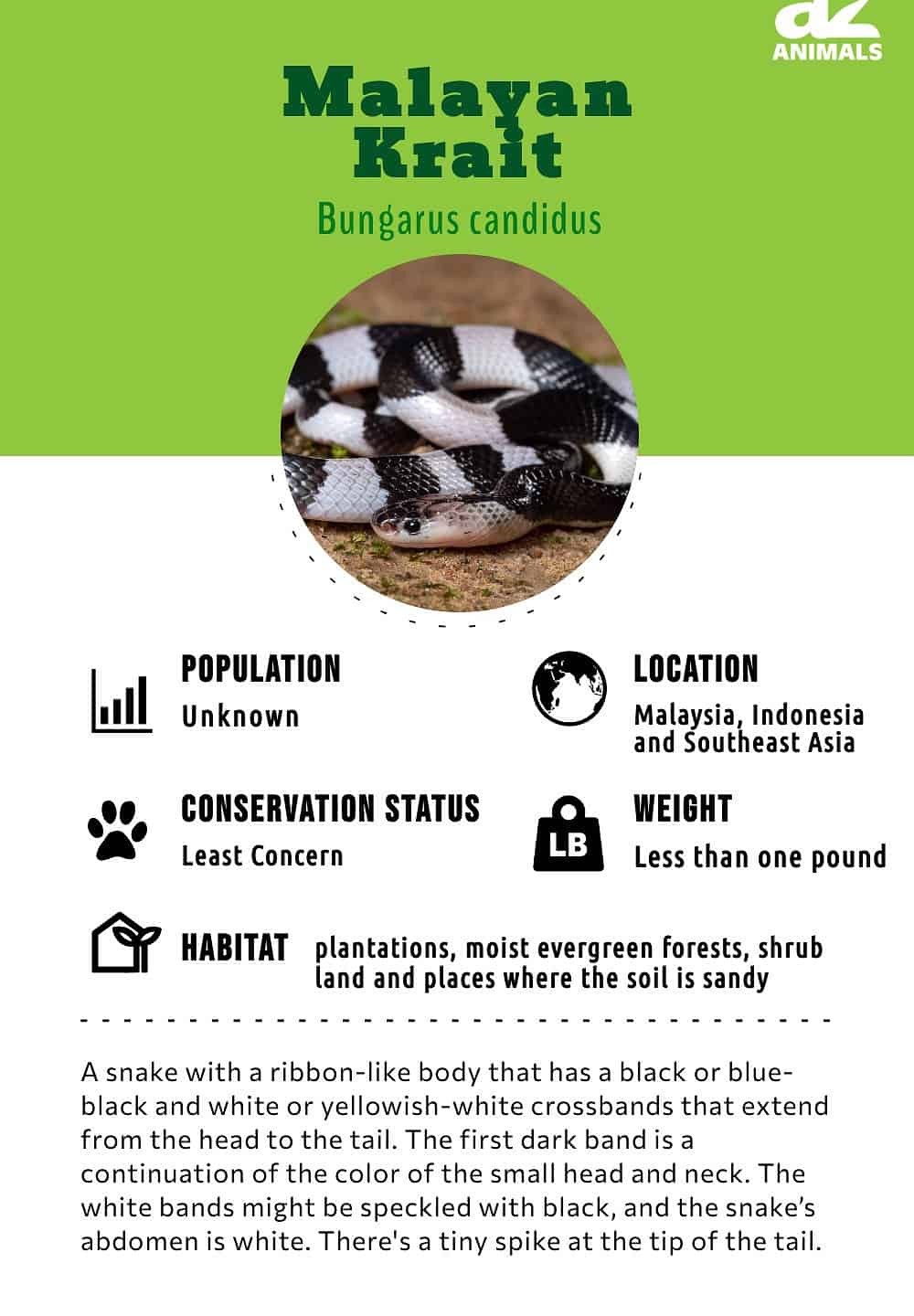
Where To Find Malayan Kraits
Malayan kraits are found, as their name says, in Malaysia. They are also found in Indonesia in the countries of Bali and Java. The snake also lives in southeast Asian countries such as Cambodia, Myanmar, Thailand, Vietnam, and Laos. They are also found in Singapore. They prefer a habitat that’s close to water, and so can be found in plantations, moist evergreen forests, shrub land, and places where the soil is sandy. They are found at elevations as high as 3937 feet.
Scientific Name
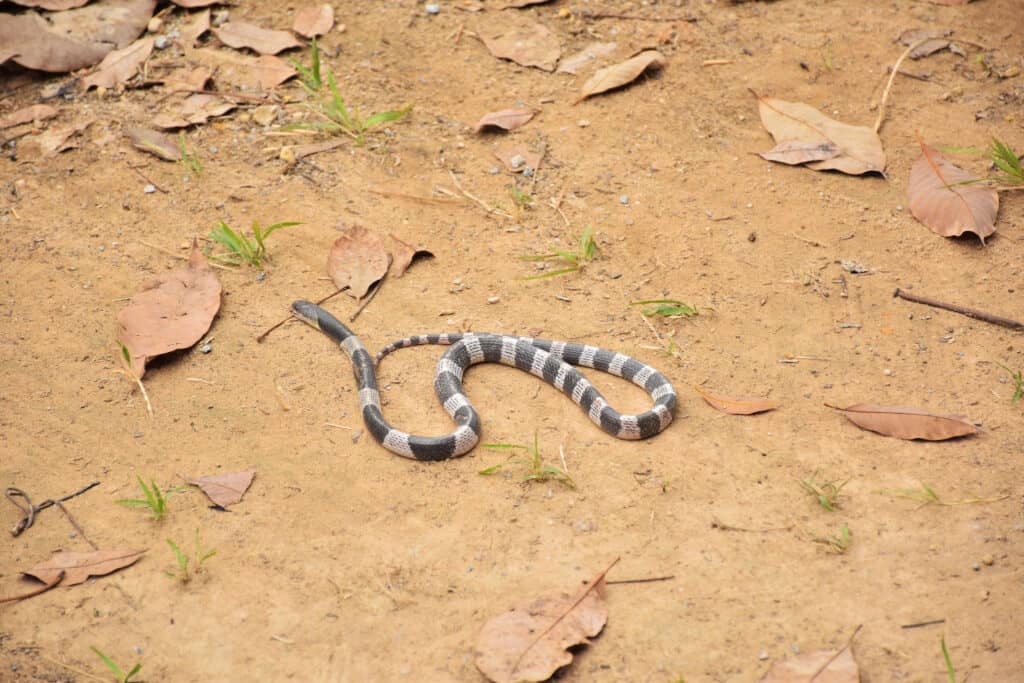
The Malayan Krait’s scientific name is
Bungarus candidusand it has no subspecies.
©Patnaree Asavacharanitich/Shutterstock.com
The scientific name of the Malayan krait is Bungarus candidus. Bungarus is from the Telugu word baṅgāru, which means “golden.” This most likely refers to the Malayan krait’s cousin the banded krait, whose bands are golden instead of white. Candidus is Latin for “shining white.” The Malayan krait has no subspecies.
Evolution And Origin
All modern snakes of today can be traced back to just a few species of snakes that lived 66 million years ago, during the Cretaceous–Paleogene era, and were alive, and survived, the extinction event that occurred during this time. As a result of snakes’ ability to go underground, they were able to not only survive but move into new habitats and new environments which then created a diversification of their species.
The Different Types Of
Though the Malayan krait has no subspecies, there are several species of krait in the Bungarus genus. They include the banded krait, the common krait, the Ceylon krait, the red-headed krait, and the Burmese krait. Other members of the genus are the northeastern hill krait, the South Andaman krait, the Sind krait, and the Persian krait.
Appearance And Description
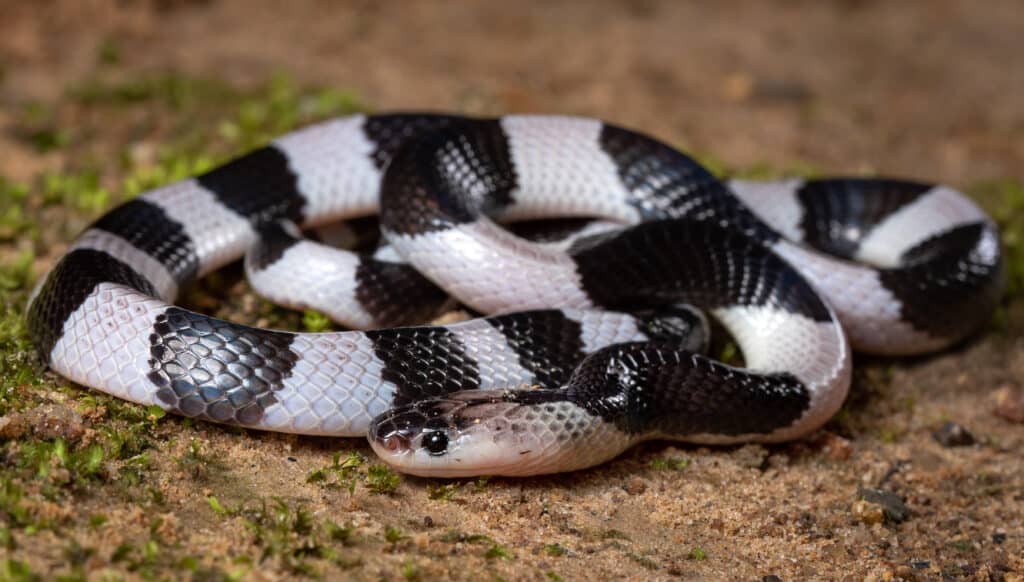
The Malayan Krait is one of the most dangerous snakes in the world!
©Nenad Preradovic/Shutterstock.com
The Malaysian krait is a snake with a ribbon-like body that grows to about 3.6 feet in length. The most striking thing about the snake is its black or blue-black and white or yellowish-white crossbands that extend from the head to the tail. The first dark band is a continuation of the color of the small head and neck. The white bands might be speckled with black, and the snake’s abdomen is white. There’s a tiny spike at the tip of the tail. The scales along the snake’s back and sides are smooth, the nostrils are large, and the eyes are small with round, black pupils. The Malayan krait can be found in several types of habitats, especially those that are near bodies of water.
The Malayan krait should not be confused with a sea krait. Sea kraits are members of the Laticauda genus, and they are semi-aquatic. Though they resemble terrestrial kraits such as those in the Bungarus genus, their tails have evolved to resemble paddles and help them swim. However, sea kraits, like Bungarus kraits still have to lay their eggs and digest their prey on land.
Venom: How Dangerous Are They?
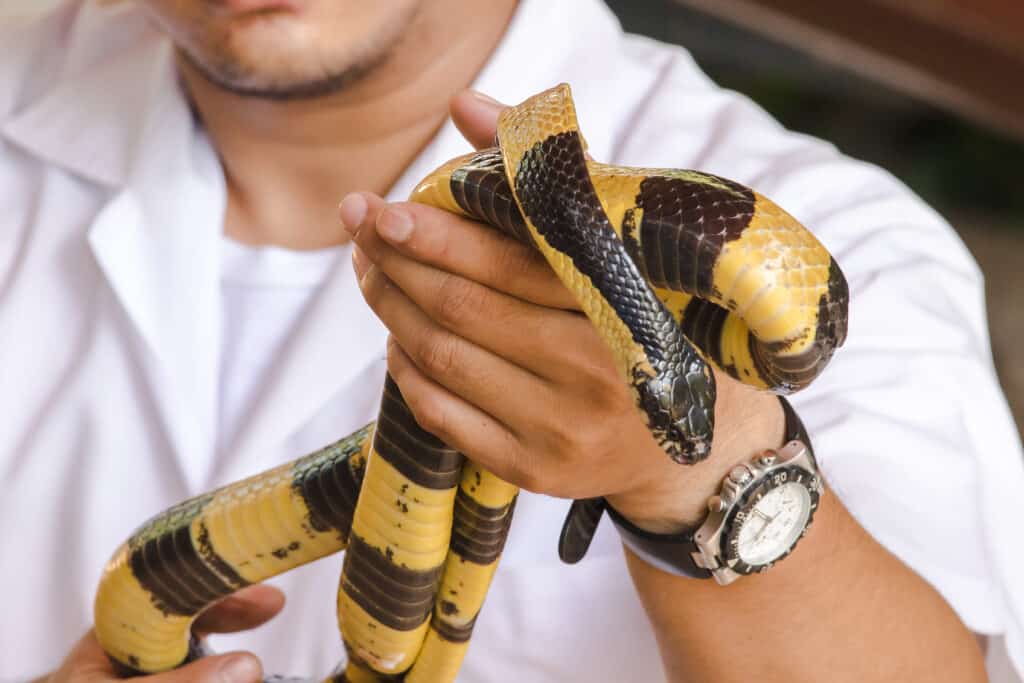
Though wildly dangerous, the Malayan krait has a reputation for being docile.
©PURIPAT PENPUN/Shutterstock.com
The Malayan krait is one of the most dangerous snakes on earth, and even juveniles are dangerous The mortality rate for an untreated envenomation is a stunning 60 to 70 percent. The snake’s venom is made up mostly of neurotoxins, which means it attacks the nervous system. After a bite, a person may experience nausea and vomiting, headache, stomach pain, dizziness, and diarrhea. Paralysis and convulsions happen when the nerves stop working the way they should. Without treatment, the person may die within 12 to 24 hours of being bitten. Fortunately, there is an antivenin for the venom of a Malayan krait.
Behavior And Humans
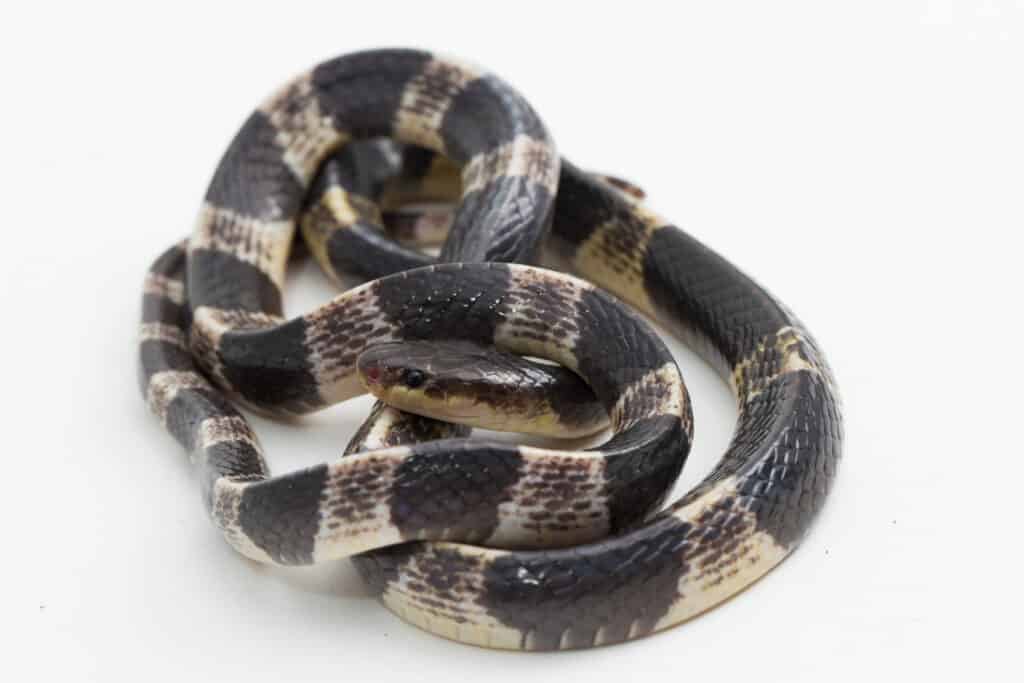
The Malayan krait is a surprisingly docile nocturnal snake.
©dwi putra stock/Shutterstock.com
Though it may attack when cornered, the Malayan krait is surprisingly docile and shy. Found in a variety of habitats from moist forests to plantations to rice paddies to villages, it is a nocturnal snake that hides during the day. If it’s found in its hiding place, it will slither away quickly or try to cover its head with its own tail to avoid trouble. It can strike without any threat display if it feels it can’t escape.
The blue krait hunts for its prey at night which is unusual for venomous snakes. Other venomous snakes tend to lie in wait for prey, ambush them and wait for their venom to kill or incapacitate them before swallowing them. Bungarus candidus eats other snakes and now and then takes a lizard or a small mammal. They lay eggs, often in the burrow of a rat they’ve probably had for dinner.
Males seem to engage in ritual combat for the right to mate, and the eggs are laid in the spring and hatch in the summer. The female lays about four to 10 eggs, and when the babies are born they’re about a foot long and look like the adults. Juveniles are fully independent and have a good supply of venom from birth.
The blue krait’s conservation status is the least concern though it is used for food, skin, and traditional medicine.
View all 164 animals that start with MMalayan Krait FAQs (Frequently Asked Questions)
How venomous is the Malayan krait?
The Malayan krait is extremely venomous. If a person isn’t treated, the chance of death from a blue krait bite is between 60 and 70 percent. Even if the wound is treated, the probability of death is about 50 percent.
Are Malayan krait aggressive?
The good news is that this snake is not aggressive at all and can even be picked up and handled during the day and sometimes even at night.
Where do Malayan Kraits live?
Malayan kraits live in a variety of habitats close to bodies of water in countries such as Indonesia, Malaysia, Cambodia, Laos, Vietnam and Thailand.
Is blue krait found in India?
Interestingly, the blue krait does not seem to be found as far west as India. Other species of krait are found in India, including the banded krait, the common krait, Sind’s krait, Wall’s krait and the Andaman krait.
What do blue kraits eat?
Blue kraits eat other snakes, including each other. Other prey include lizards, frogs and small rodents such as mice.
Thank you for reading! Have some feedback for us? Contact the AZ Animals editorial team.
Sources
- Wikipedia (1970) What do blue kraits eat? / Accessed May 10, 2022
- Reptile-Database / Accessed May 10, 2022
- Thai National Parks / Accessed May 10, 2022
- Snack Facts / Accessed May 10, 2022
- ITIS / Accessed May 10, 2022
- Clinic Toxinology Resources / Accessed May 10, 2022
- Walk Through India / Accessed May 10, 2022














